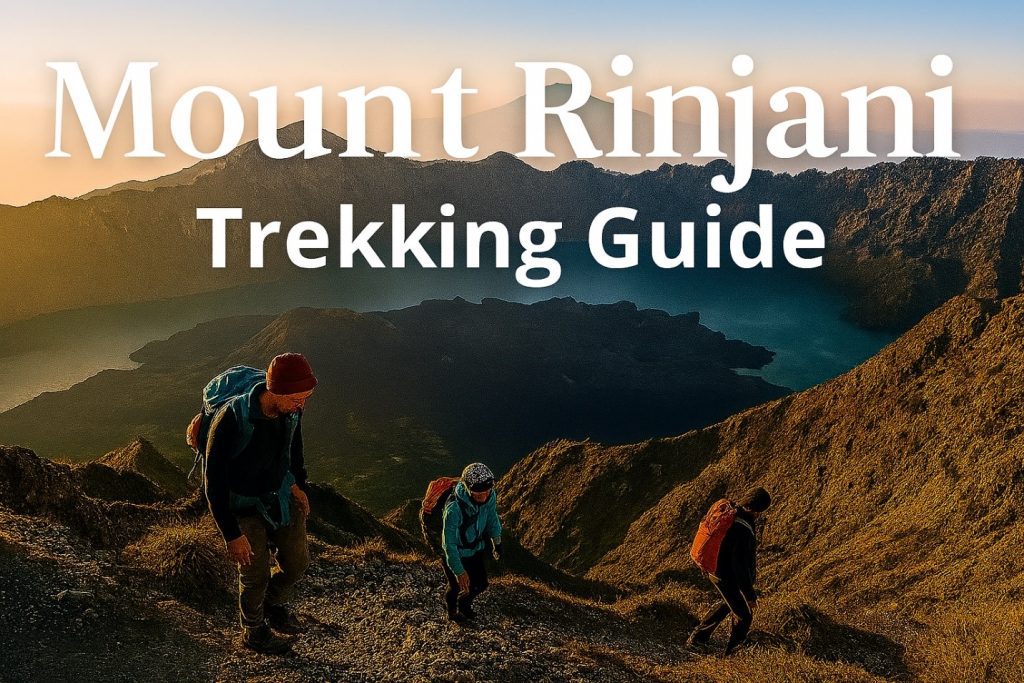Mount Rinjani, soaring to an impressive 3,726 meters above sea level on the island of Lombok, Indonesia, is a majestic stratovolcano and a dream destination for trekkers worldwide. It is the second-highest volcano in Indonesia and is famous for its dramatic caldera, the turquoise-blue Segara Anak crater lake, and the spectacular sunrise views from its summit.
Trekking Mount Rinjani is a challenging but immensely rewarding adventure. It requires good preparation, a reasonable level of fitness, and the mandatory use of a licensed trekking guide and porters, who are the unsung heroes of the mountain. This guide will walk you through the essentials for your unforgettable journey.
The Main Rinjani Trekking Routes
Choosing your route and duration is the first step in planning your Rinjani Trekking. The treks vary significantly in difficulty, scenery, and the key highlights they reach.
Sembalun Route: The Path to the Summit
- Starting Point: Sembalun Village (1,156m)
- Key Feature: This is the most popular route for those determined to reach the Rinjani Summit (3,726m).
- Difficulty: Very challenging, especially the final summit push, which involves climbing extremely steep volcanic sand and scree—often described as “two steps up, one step back.”
- Typical Duration:
- 3 Days / 2 Nights: The standard, most recommended package to reach the summit and visit the crater lake.
- 2 Days / 1 Night: An ultra-challenging option for experienced and very fit trekkers, focused solely on the ascent to the summit and immediate descent back to Sembalun.
Senaru Route: For the Crater Rim Views
- Starting Point: Senaru Village (601m)
- Key Feature: Leads through a lush tropical rainforest and up to the stunning Senaru Crater Rim (Plawangan Senaru, 2,641m). This rim offers breathtaking views of the lake, the smaller cone of Mount Barujari inside the caldera, and the main summit.
- Difficulty: Challenging, featuring a steep, non-stop climb through the jungle.
- Typical Duration: 2 Days / 1 Night is perfect for those who want a shorter, less demanding trek focused on the crater rim and its incredible views, without the extreme difficulty of the summit.
Trekking Highlights and Duration Options
Your trip duration largely dictates what you’ll see. Most packages combine the Sembalun and Senaru routes into a one-way adventure to maximize the experience.
3 Days / 2 Nights (Sembalun to Senaru)
This is the classic, full-experience trek.
- Day 1: Ascend from Sembalun to the Sembalun Crater Rim.
- Day 2: Early morning summit push, descent to Segara Anak Lake to bathe in the natural hot springs, then a climb to the Senaru Crater Rim campsite.
- Day 3: Long descent through the forest back to Senaru village.
2 Days / 1 Night (Senaru Crater Rim)
The best choice for beginners or those short on time. It offers the majestic caldera view without the summit’s gruelling difficulty.
Segara Anak Lake and Hot Springs
A beautiful, sacred destination inside the caldera. The lake is about 600 meters below the rim, and a short walk from the lake takes you to rejuvenating natural hot springs, which are a perfect reward for tired muscles.
Essential Preparation for Your Rinjani Trekking
Rinjani Trekking is not an ordinary hike. Proper preparation is the key to safety and enjoyment. The weather can change rapidly, and the high altitude means cold nights and a chilling pre-dawn summit climb.
Physical and Mental Readiness
The trails are steep and rugged. Start cardio training (running, cycling) and leg-strengthening exercises (squats, lunges) at least one month before your trip. The trek is as much a mental challenge as a physical one, especially the exhausting summit push.
What to Pack
Remember that your porters carry the tents, food, and cooking gear; you only need a small personal backpack (daypack) with essentials.
- Warm Layers: The temperature at the crater rim and summit drops to 0-5°C. Bring a warm hat, gloves, thermal layers, and a fleece/down jacket.
- Outerwear: A lightweight, waterproof and windproof jacket is essential.
- Footwear: Sturdy, broken-in trekking boots with good ankle support.
- Gear: A headlamp (with spare batteries for the pre-dawn climb), high-factor sunscreen and lip balm, personal first-aid kit (especially blister plasters and pain relievers), and trekking poles (highly recommended for both ascent and descent).
Booking and Safety
All trekkers must use a licensed tour operator. Your package should include:
- A professional, English-speaking guide and porters.
- All camping equipment (tents, sleeping bags, mattresses).
- Meals and drinking water (3 liters per person per day).
- Mount Rinjani National Park entrance fees and permits.
Book your tour in advance, especially for the dry season (April to November), as the National Park enforces a daily quota on trekkers for safety and sustainability.
Mount Rinjani Trekking offers an unparalleled adventure—from the steep climbs through lush forests to the moment you stand at the summit, watching the sunrise paint the sky above the caldera. Prepare well, respect the mountain, and you will be rewarded with an experience of a lifetime.


